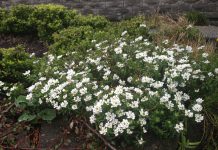I’m vacationing this week in Oregon, visiting my webmaster Evan in Eugene and also my friend Janie who lives in the historic mining town of Jacksonville near Ashland. We have taken several trips together, including the Mayan ruins in Mexico and birding in Southeast Arizona. But the trip we both think might have been our favorite was the one we took to Eastern Poland.
From kayaking and hiking to exploring forests, heritage sites, churches and especially the gardens of the people we met, we still talk about it when we get together. Here are some of the highlights of that trip.
The first thing you notice in Poland are the flowers. Although winters are harsh in this country, spring starts suddenly in April after the snow melts. The climate in eastern Poland is influenced by the interior of the continent towards Russia and so receives summer rain. The wildflowers, vegetable gardens, perennial and annual flowers love the moisture and were in full bloom.
This part of Poland is protected from any industry. A primeval forest and several national parks are here. Agriculture makes up 50% of land use in this country. Even during the Communist control, a farmer was allowed to keep 3 hectares of land for himself. Land ownership provided some freedom and even to this day little land comes up for sale.
I couldn’t help but fall in love with the neat farm houses made of brick, local multi-colored granite, wood or brightly painted stucco most with a red roof and surrounded by a flower garden, a vegetable garden and always a fence. I’ve never seen so many kinds of fencing—ornamental iron, willow branches woven together, fancy picket fences or concrete cast to look like wooden bed posts.
The sandy soil here was deposited by glaciers, the last one only 10,000 years ago and is rich with sediment and nutrients. Sunflowers grow tall between fields. Black-eyed Susan grow wild covering the hillsides with gold and every garden had hydrangea, petunia, geranium, yellow mullein, scabiosa, canna lily, dahlia, chicory, apple and plum trees, grapes, hollyhock, marigold and sweet peas.
I was amazed at the number of annuals that were grown. Marigolds and petunias of all colors and styles are very popular and probably started from seed as I never saw a nursery of any type even in the outdoor markets. Tender perennials are overwintered inside or cuttings taken in the fall.
A typical vegetable garden had rows of cabbage, of course, as well as red beets, several types of potatoes, lettuce, carrots, onion, cauliflower, cucumbers and leeks. Tomatoes are very popular but grown in greenhouses. Even short-season, cold-tolerant tomatoes like Early Girl or Stupice are grown inside.
Red currants, blueberries, blackberries and raspberries are commonly grown. Fields of sunflowers surround farmhouses. Brightly colored bee hives find a home in many orchards. Pigs are kept in barns but dairy cows graze in the meadow. Geese, chickens and goats are common.
Poland has more than 3,500 species of mushrooms and hunting for them is a traditional pastime. I enjoyed many soups and other recipes made with wild mushrooms. Two million private farms grow most of the potatoes and rye for Europe and is one of the worlds largest producers of sugar beets. and triticale, a self-pollinating hybrid of wheat and rye, leading Poland to be called the future breadbasket of the European Union.
I’d love to go back to Poland. It’s a beautiful country rich in history and the gardens are spectacular.
Jan Nelson, a landscape designer and California-certified nursery professional, will answer questions about gardening in the Santa Cruz Mountains. Email her at ja******@*ol.com, or visit jannelsonlandscapedesign.com.













